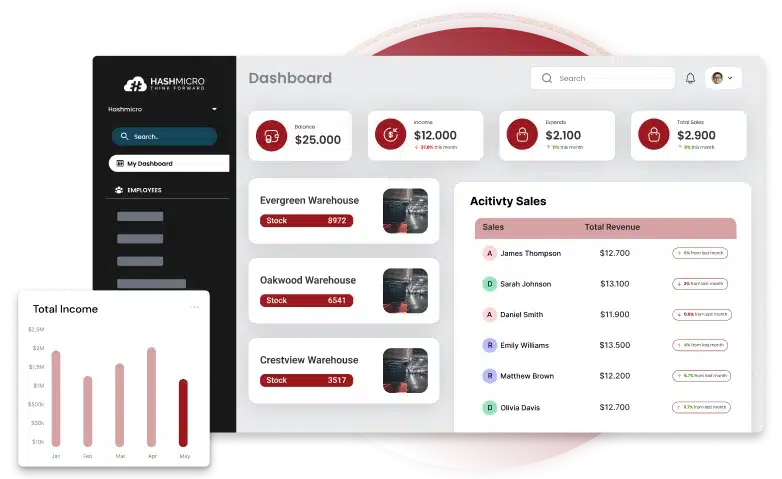Did you know that two-thirds of companies are already piloting the automation of business processes across their operations? With 57% of them utilizing business process automation (BPA) platforms, it’s clear that automation is becoming the new norm. How about your company—are you on board yet?
Business expert Timothy F. Geithner once said, “Financial stability cannot depend on omniscient supervisors identifying and preemptively defusing any potential source of crisis; it requires safeguards that can help the system withstand the force of a severe storm, and tools the government can use to limit the damage.”
This insight highlights how essential strong automation systems are for business. Automation isn’t just changing how companies operate—it’s becoming a key factor in keeping businesses resilient.
This article will explain the definition, ins and outs of business process automation (BPA), and strategies for successfully implementing it in your business.
Key Takeaways
|
What is Business Process Automation?
A business process refers to any sequence of activities that helps a company achieve a specific objective. In automation, this usually means a repeatable series of steps that span multiple IT systems.
Examples of business processes include fulfilling and invoicing customer orders, approving loan applications, completing data entry, onboarding new employees, and other tasks related to financial services, human resources, and business operations.
When business processes are managed ad hoc, they can quickly become cumbersome and prone to errors. Endless email exchanges, misplaced documents, and handoffs can lead to communication breakdowns, bottlenecks, and missed deadlines. Alamak!
As business grows, these challenges only multiply, causing inefficiencies to snowball and productivity to suffer.
That’s where business process automation comes in. Sales automation tools simplifies and streamlines the tasks that drive business forward. With automated processes, companies can eliminate manual errors, reduce bottlenecks, and accelerate progress toward their goals.
The result? Improved efficiency, enhanced productivity, and a competitive edge in the market.
Examples of Business Process Automation

Business processes suitable for automation can be found across various business areas, including management, operations, supply chains, HR processes, and marketing. Typically, the best candidates for automation are tasks that are high-volume, recurring, time-sensitive, involve multiple people, and require compliance and audit trails.
Business process automation use cases include the following:
- Onboarding new employees: Integrating new hires involves many detailed tasks, such as filling out forms, scheduling training, and setting up direct deposit. Automating this process reduces paperwork, ensures all steps are completed, and keeps managers informed.
- Onboarding new customers: In financial services, companies must conduct background checks and report new customers as part of compliance requirements. Automating these processes with AI streamlines tasks, speeds up onboarding, and enhances customer satisfaction.
- IT service desk support: The influx of IT tickets often exceeds staff capacity. Automation software can sort, classify, and route tickets to the right personnel, provide updates, and alert IT staff to urgent issues, improving overall support efficiency.
- Marketing automation: Marketing automation tools enable companies to send targeted messages across various channels like email and social media. This technology helps streamline repetitive tasks, making marketing efforts more efficient.
Use Cases of Business Process Automation
BPA can be applied to any process in any department, offering flexibility that makes it ideal for coordinating business operations across an entire organization. Here are some specific ways BPA can be used in different departments:
- Finance and Procurement: BPA helps finance and procurement teams automate tasks like routing reimbursements or purchase approvals, speeding up credit approvals, and standardizing processes to ensure security and compliance. Key areas that benefit from BPA include purchasing, accounts receivable, and expense reimbursements.
- Sales and Marketing: BPA boosts efficiency for sales and marketing by reducing the time spent on fulfilling marketing requests and speeding up the customer onboarding process. It integrates with existing CRMs to automate sales processes, close gaps, and break down data silos. If an enterprise CRM isn’t available, BPA can be used to create a low-code CRM or manage sales pipeline stages. Additionally, teams can enhance their automation capabilities by integrating advanced tools like API sales, which streamline data synchronization between CRMs and external platforms for more efficient sales operations.
- HR/People Operations: HR teams strive to make the employee journey seamless. BPA helps by speeding up hiring and onboarding and integrating with HR systems. Besides, 42% of organizations prioritize improving employee experience through transformed processes.
Benefits of Business Process Automation

BPA enhances efficiency and standardization, leading to several key business benefits, including:
- Increased productivity: Automating repetitive tasks saves time, allowing employees to focus on higher-value work, which boosts overall productivity. 61 percent of respondents say their companies have met their automation targets using good strategies and BPA combined.
- Lower costs: By replacing manual tasks with automation, businesses reduce the need for extensive human resources, leading to significant cost savings.
- Reduced human error: Automation minimizes the chances of mistakes that often occur with manual processes, ensuring more accurate and reliable outcomes.
- Greater employee satisfaction: By automating mundane tasks, employees can engage in more meaningful and rewarding work, leading to higher job satisfaction.
- Higher revenue: Increased efficiency and accuracy from automation contribute to faster processes and better customer experiences, ultimately driving higher revenue.
- Improved customer service: Automation speeds up processes like customer onboarding and service responses, enhancing customer satisfaction and loyalty.
- Insights into process success and failures: BPA software provides visibility into all process steps on a single dashboard, enabling businesses to monitor and analyze the success and failures of their workflows.
- Better auditing and compliance: Automated processes ensure compliance regulations are consistently followed, making auditing simpler and more effective.
- Simplified compliance management: BPA systems help businesses easily manage compliance by centralizing and standardizing processes, reducing non-compliance risk.
By integrating automation, organizations streamline their operations and gain transparency and control over their workflows, essential for successful digital transformation.
For further insights, you can also explore other articles related to sales force automation to deepen your understanding and discover practical strategies for implementation.
What Business Processes Should You Automate?
It might seem like BPA is the solution to all your challenges, and it will likely play a crucial role in transforming your business and lightening your workload.
However, to ensure successful BPA implementation, it’s essential to identify the processes that are ideal for automation.
These processes typically:
- Are inherently repetitive
- Involve multiple people and complex elements
- Are time-sensitive
- Require compliance and audit trails
- Have a significant impact on other systems and processes
Strategies to Automate Business Processes

Ensuring close collaboration across departments becomes critical as automation programs expand and grow more complex. When teams don’t coordinate, it can lead to bottlenecks and hinder performance.
All teams need to work together, share information, and align their goals to get the most out of automation. To ensure that you can successfully implement BPA while minimizing the risks, pay attention to these 13 strategies:
1. Prioritize automation strategically
McKinsey’s research shows that companies that succeed with automation do one thing differently: they make it a top priority. In 2018, successful companies were twice as likely to have made automation a key part of their overall business plan.
The 2020 results confirm this. Among companies that did well with automation:
- 38% said they prioritized automation when planning their business strategy (compared to just 10% of other companies).
- 72% said making automation a priority was a key reason for their success.
In contrast, companies that struggled with automation often did it for smaller reasons, like saving money, keeping up with competitors, or fixing problems with their processes.
2. Balance focus on people and technology
Companies that succeed with automation consider the human elements in three key ways:
- Building employee skills: Successful companies prioritize addressing skill gaps and investing in employee training and capability building. In fact, respondents from successful companies are more than twice as likely to credit employee training as a key reason for their automation success.
- Tapping into human expertise: They involve employees in designing automation solutions, using “human in the loop” approaches that train automation platforms with people’s input over time.
- Communicating change: They prioritize communication across the organization, formally involving the communications and HR functions to ensure a smooth transition.
3. Design an operating model that supports scaling
Studies reveal that large companies typically automate at least one business process in an average of four functions, including finance, IT, and customer service. As these automation programs expand and become more complex, a lack of coordination between different departments can hinder their effectiveness.
Successful companies, however, have operating models that ensure seamless coordination across the organization, allowing them to manage the complexity of automation technologies more effectively. This coordination is crucial for scaling automation efforts.
In fact, respondents from successful companies are more likely to highlight that cross-functional collaboration will play a key role in the success of automation initiatives in the coming years.
4. Pinpoint areas requiring functional improvements
The first step in developing a business process automation strategy is systematically identifying areas that need improvement. While occasionally stumbling upon processes to automate can work, it’s not a reliable strategy for long-term success.
To identify areas for automation, smart businesses review and evaluate their current processes, focusing on those that are inefficient, redundant, or prone to errors. They can do this by analyzing data and talking to employees.
Data analytics reveal where bottlenecks occur, errors happen frequently, or costs exceed expectations. Conversations with employees provide insight into why these issues exist and can uncover other potential improvements that data alone might miss.
For example, data might show that payments take longer to process after busy periods, suggesting a need for accounting automation. However, by talking to your billing team, automating customer relationship management (CRM) could have an even greater impact.
5. Identify repetitive tasks
Once you’ve pinpointed areas needing improvement, the next step is to decide which tasks best suit automation. Technology excels at certain tasks, especially repetitive ones, where it can significantly boost efficiency.
Automating repetitive tasks is often more time-consuming and costly upfront than manually performing them a few times, but the long-term gains are substantial. For example, in a sales department, automating purchase confirmations is straightforward since the messages are nearly identical, with just a few changes.
However, responding to varied customer questions is more complex. While AI chatbots can handle common queries, automating these responses is much harder. It’s best to start with tasks where technology outshines manual work.
6. Determine priority areas for automation
When identifying tasks for Business Process Automation (BPA), the key is to focus on what will have the greatest impact on your business. If you’re new to BPA, start with easier tasks to automate to build confidence and skill.
Some companies prioritize automation by aligning it with specific business goals, like cost-cutting or scaling for growth.
Others focus on automating processes within specific business units, especially in regulated industries, or by process type to improve efficiency. Ultimately, the best approach is the one that addresses your most pressing business needs.
7. Develop a comprehensive plan

When designing a major business process change, it’s crucial to create a comprehensive plan that considers not only the task being automated but also the broader impact on related processes and the entire company. Consider these key aspects:
- Whole Process Evaluation: Don’t focus solely on the easy-to-automate tasks. Ensure the overall improvements justify the investment in automation. Instead of making multiple small changes, consider a full overhaul at once to minimize disruptions—like combining outbound email automation with a CRM upgrade to avoid repetitive work.
- Upstream, Downstream, and Adjacent Impacts: Consider how automation will affect related processes. For instance, will the software handle inputs previously managed manually, and how will the output be used or interpreted?
- Company-Wide Considerations: Focus on automation’s transformative potential, not just individual process efficiencies. Automation can free up staff for higher-value tasks like product design. Prioritizing these processes might yield long-term benefits that surpass immediate gains.
8. Define roles clearly
It’s crucial to define clear roles for those involved in implementing, maintaining, and working with automated processes. Automation doesn’t mean every step remains unchanged—humans must ensure that tasks are completed correctly and exceptions are handled.
Assign specific responsibilities for managing inputs, overseeing results, handling errors, and managing outputs.
For example, in automating an invoicing process, an accounting system can handle tasks like generating invoices and adding customer details. However, humans must still generate billing information and review invoices before sending them. Here’s how responsibilities might be divided:
- Sales Team: Record orders and ensure customer data in the CRM is up to date.
- Invoicing Specialist: Trigger invoice generation, check for accuracy and approve before sending.
- Sales Manager: Set the system’s rules and procedures to generate invoices.
- IT Department: Provide technical support and ensure the system runs smoothly during business hours.
This example highlights that adding technology often increases IT responsibilities. It’s wise to involve them early in planning and ensure they have sufficient resources to support other departments effectively. Avoid the pitfall of enthusiastically rolling out automation while leaving IT teams understaffed.
9. Implement standard operating procedures (SOPs)
Standard operating procedures (SOPs) outline the steps involved in specific tasks or processes, making it easier for employees to transition into new roles and cover for one another. SOPs also facilitate automation by clearly defining the steps to be automated.
Large organizations rely on SOPs for consistent process replication and results, especially given regular employee turnover and the need to replicate procedures across multiple teams and locations.
However, smaller businesses often overlook the importance of SOPs. Startups may avoid SOPs to stay agile and avoid documenting processes everyone already knows.
Yet, as the company grows and experiences turnover, relying on institutional memory can lead to inconsistencies and inefficiencies. Without clear procedures, it becomes challenging to resolve these issues through automation.
10. Incorporate business process management
Business process management (BPM) is a structured approach to improving frequently executed organizational processes. While BPM doesn’t always require automation, it often involves it.
Business process automation is a key and growing aspect of BPM, with the techniques used to document and enhance human processes also applicable to automated ones.
11. Ensure thorough user training
Training users is crucial when automating business processes, yet some companies delay it until it’s too late. Employees need training not only on the new technology but also on the new processes.
While companies often recognize the need for technology training, they may overlook the need to train employees on new procedures, even for those not directly interacting with the technology.
Timing is a critical aspect of training. It shouldn’t start too early before processes are fully defined, nor too late after the old process is completely replaced. Sometimes, delaying deployment to allow for adequate training is necessary, preventing future issues from employees learning on the job.
12. Have backup plans prepared
What if automation doesn’t work as expected? What if a supplier changes their software or goes out of business? Or if changes to another workflow disrupt your automated process? The solution is to have a backup plan, such as reverting to the old, non-automated method.
It’s crucial to be prepared. While business process automation can be transformative, no deployment is guaranteed flawless.
13. Use ERP software
For many companies, ERP software is integral to business process automation (BPA), enhancing the value created by automation. Built-in automation capabilities can save time and money, reduce errors, improve consistency, and streamline tracking.
With ERP, businesses can automate various functions using a single integrated platform, from sales and finance to manufacturing.
ERP adds value to BPA by integrating data across processes, geographies, and functional areas. This integration allows data from one process to enhance another, such as using automated reporting for predictive analytics or detecting performance anomalies across business units.
BPA offers numerous benefits, including cost reduction, faster processes, and fewer errors. Automation frees employees from repetitive tasks, allowing them to focus on higher-level work that adds greater value to the organization.
However, not every process is suitable for automation, and poorly executed initiatives may fail. By following best practices in selecting and implementing automation, companies can maximize the success of their BPA efforts.
Automate Your Business Processes with HashMicro ERP Software

HashMicro offers an all-in-one solution for businesses aiming to centralize and automate their operations on an easy-to-use platform–as one of the best ERP software in Singapore.
Imagine automating your entire business process—from inventory tracking to order fulfillment—saving time, cutting costs, and reducing errors simultaneously. Sounds impressive, right?
With HashMicro’s ERP system, you can streamline every aspect of your operations. Real-time updates ensure that your inventory, finances, and other critical processes are always accurate and up-to-date, eliminating guesswork and minimizing mistakes.
HashMicro provides everything you need to make this happen:
- Automating inventory tracking and management
- Integrating real-time updates across all departments
- Streamlining order fulfillment and other key processes
If you’re ready to elevate your business operations, consider investing in HashMicro’s ERP system today. You’ll be amazed at how much more efficient and cost-effective your business can become.
For a complete approach to automating your processes, get a free demo of HashMicro’s ERP software now!
Warning: Undefined array key "med" in /home/hashmicr/public_html/blog/wp-content/plugins/insert-headers-and-footers/includes/class-wpcode-snippet-execute.php(419) : eval()'d code on line 281

FAQ About Business Process Automation
-
What is the difference between RPA and BPA?
RPA targets specific tasks, whereas BPA takes a broader approach by overhauling your entire workflow, guided by business process management best practices.
-
Is ERP a business process automation?
Yes, ERP can serve as a business process automation tool. The abas ERP system, for instance, is designed with emerging technologies and includes built-in BPM and BPA capabilities, making it a powerful solution for automating business processes efficiently.
-
How do you implement BPA?
1. Get Your Team Ready: Clearly communicate the benefits and objectives of business automation to your team. Make sure everyone knows their roles and responsibilities during the implementation.
2. Set Up the Tools: Install and configure the chosen BPA tools, ensuring they integrate seamlessly with your current systems and processes.































